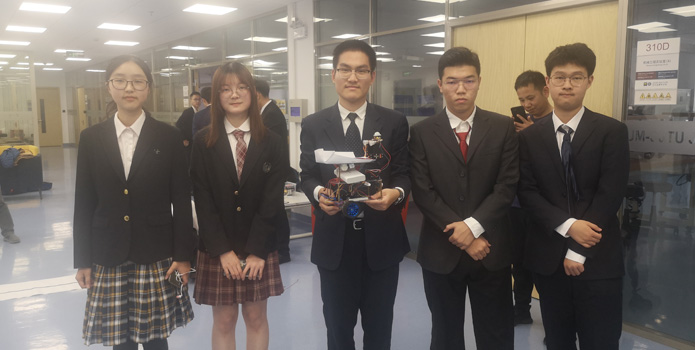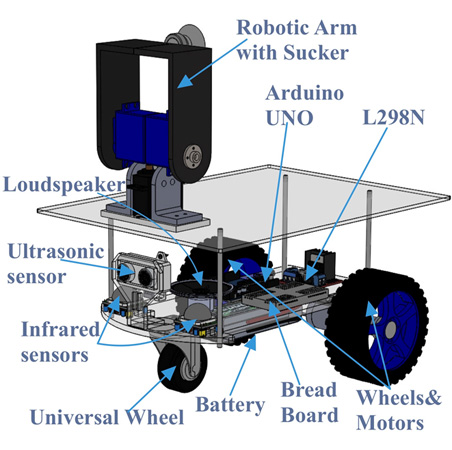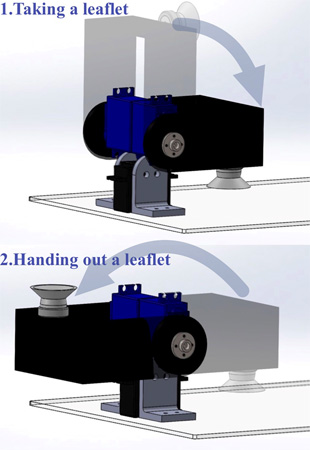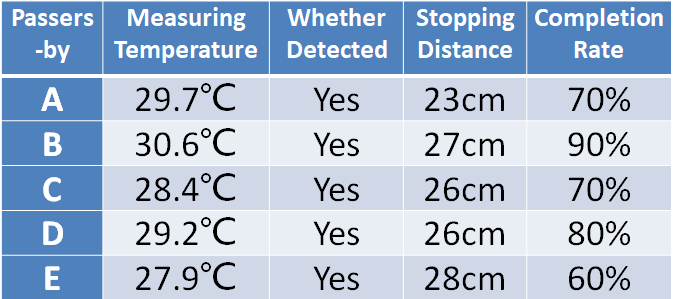
Student Projects
VG100

Automatic Leaflet Distributor
Instructors: Dr. Mian Li, Dr. Irene Wei
Team Members: Nuocheng Ji, Yuexin Min, Zichun Wang, Wenbo Yu, Hanyu Ying
Project Video
Team Members

Team Members:
Nuocheng Ji, Yuexin Min, Zichun Wang, Wenbo Yu, Hanyu Ying
Instructors:
Dr. Mian Li, Dr. Irene Wei
Project Description
Problem
Sending out leaflets and posters to advertise for clubs or activities in college is a simple, boring and repetitive work which consumes time and energy of college students. So it’s hard to recruit people to do this work. The existing robots which can distribute leaflets is designed for businesses and isn’t suitable for college students.
Concept Generation
Our project aims at building a special type of car equipped with infrared and ultrasonic sensors, a loudspeaker and a robotic arm with a sucking disc, which can identify people nearby, attract them and pass the poster to them. It can efficiently help college students distribute leaflets and posters.
Design Description
A automatic leaflet distributor based on Arduino-controlled system is our final solution. Arduino Uno is used to control the car with designed code. It control the car to find a passer-by, move to him while making a sound, stop before him and then control the robotic arm to give a poster to him.

Fig. 1 The structure of the distributor

Fig. 2 The working steps of the robotic arm
Modeling and Analysis
The way to realize our project is
mainly divided into four parts. Firstly, to make sure that the car will only execute the next command when it detects a human, we set a proper detection temperature range from 30℃ to 37℃. We have taken the effect of people’s clothes into account. Secondly, after the car detects someone nearby, the data will be transmitted to the device through the UNO board, and then the sound transmission device will execute the command to let the recorded voice be played out, so as to attract people in front of the car. Thirdly, a person is regarded as being interested in the leaflet if the infrared sensor continuously detects him or her. Then the robotic arm with sucker will suck a leaflet and turn it towards the person. Fourthly, when the car was in an empty square, it was given random instructions to move randomly to look around for passers-by.
mainly divided into four parts. Firstly, to make sure that the car will only execute the next command when it detects a human, we set a proper detection temperature range from 30℃ to 37℃. We have taken the effect of people’s clothes into account. Secondly, after the car detects someone nearby, the data will be transmitted to the device through the UNO board, and then the sound transmission device will execute the command to let the recorded voice be played out, so as to attract people in front of the car. Thirdly, a person is regarded as being interested in the leaflet if the infrared sensor continuously detects him or her. Then the robotic arm with sucker will suck a leaflet and turn it towards the person. Fourthly, when the car was in an empty square, it was given random instructions to move randomly to look around for passers-by.
Validation
In order to measure the sensitivity of the car to detect human body temperature through infrared sensors and the working effect, we carried out ten groups of tests on each member of our team near the JI building as passers-by. The average data of each group is as follows:
Due to the season and the dressing of each person, it can be seen that the sensitivity of the car will be more or less affected, but the car can still find people and complete the task better, and there is no damage of the car in the process of searching for people by itself. Generally speaking, our products work well.

Table 1: Sample of Random Passers-by
Conclusion
The project solves the problem by providing an automatic leaflet distributor to help college students distribute leaflets and posters. One possible improvement is to largen the platform so that the distributor can contain larger posters. Through this project, we find a way of advertising to reduce the work of college students and lower the frequency of face-to-face contact. Therefore, as COVID-19 is predicted to coexist with human, this solution can greatly protect people’s health in the future.
Acknowledgement
Dr. Mian Li and Dr. Irene Wei from the UM-SJTU Joint Institute;
Teaching Assistants [Hanyang Feng and Fubo Qi] for VG100 at UM-SJTU Joint Institute.
More project information, please contact: [nicole_wzc@sjtu.edu.cn]
Teaching Assistants [Hanyang Feng and Fubo Qi] for VG100 at UM-SJTU Joint Institute.
More project information, please contact: [nicole_wzc@sjtu.edu.cn]
UM-SJTU JOINT INSTITUTE